Porcelain Insulator News
by Jack H. Tod
Reprinted from "INSULATORS - Crown Jewels of the Wire", July 1974, page 16
Preferably direct porcelain news items and questions directly to Jack H. Tod,
3427 N. 47th Place, Phoenix, Ariz. 85018. All mail will be answered if reply
stamp is enclosed, and the most newsworthy items and questions of general
interest will be published as space permits.
Dear Jack:
Our deal came through, and we got the brown Imperial similar to U-710. The
color in a real pretty shiny glaze, frosted brown with greenish streaks through
it. Then Imperial made this brown insulator, they sure made a mess of it; it is
rather crudely shaped, has some real big flat dips in the sides of its skirt and
a big gash in the side of it.
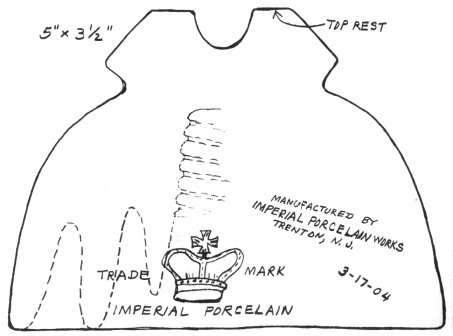
We've enclosed a rough sketch of it showing the various markings, and note
the 3-17-04 date! Noticed in your Supplement A page 225, you said a specimen has
been report- ed which bears a manufacturing date in the year 1902, and this
extends the Imperial activity in pin types even more. Have any turned up since
that was written dated later than 1902? We hope this later date has some
significance.
Ed & Judy Gish
Houston, Texas
- - - - - - - - -
Dear Ed & Judy:
Yes, you are 100% correct, and this 1904 manufacturing date by Imperial is
the one clue we have been looking for all along. It may lead to a complete
reversal of our thinking on numerous things. An you know, Imperial continued to
make other types of insulators for many years (until the 1930's as I understand
it), but we have always wondered why and when they quit making pin types.
In my book I had speculated that Imperial may have quit manufacture of pin
types as a result of the Boch patent infringement suits filed by Thomas in 1901,
and the resulting complete absence of glaze-weld designs in the 1902 Locke
catalogs. It is important to note that this 1904 specimen and some other late
Imperial designs are formed all in one piece and are not glaze-welds.
Last year I was perusing some bound library copies of patent court records of
cases during that period, and I came across a Thomas case where it appeared a judgment
reversal was made on the glaze-filling or glaze-welding process - a
ruling that the process was not novel etc. (I will look into this again next time
there.) This did ring bells with me at the time, since the other companies (New
Lexington, Ohio Brass and Locke Insulator Co.) were all making glaze-welded
insulators in profusion long before the Boch patent would have expired in 1915.
Irrespective of these patent factors, this specimen dated 1904 is important
in showing much later Imperial activity in pin types than we had previously
known, but the relative rarity of brown Imperials suggests that they quit the
game about that time or shortly thereafter. If anyone could turn up some early
paperwork (catalogs, etc..) on the Imperial operation, it might help shed
additional light on these questions.
Jack
Gerald Brown (Two Buttes, Colo.) has a new threadless porcelain and was
naturally quite excited when he told me about it some time ago. It is just one
of numerous new items reported in Gerald's book Supplement now available.
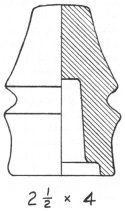
This
insulator is white and is rather crudely made. Gerald's number for it is UE 731
because it is very similar to the glass CD-731 threadless Tillotson. I don't
recall if Gerald told me whether this is a unique item or not, but I haven't
heard of any other specimen than his to date.
This is tentatively U-792 in the
Universal Style Chart.

The "insulator" above may be the ultimate in value as a museum
piece, not only to collectors of Fred Locke items but to anyone interested in
the very beginning of the high-voltage porcelain insulator industry. Although
other companies were already making high-voltage porcelain insulators before
Fred Locke decided to manufacture them himself, few will argue the fact that the
establishment of his insulator plant at Victor, N.Y. was the real foundation of
the high-voltage porcelain insulator industry.
Just as Fred Locke had Brookfield make large glass insulators to his design
for the first transmission lines, he also later had porcelain insulators made to
his design by other companies before he built his own plant in 1898. A few dry
process units were made for him by Electrical Porcelain & Manufacturing Co.
(Trenton) and later a great number of wet process ones made by Imperial
Porcelain Works (Trenton, N.J.).
There are written references to Fred Locke having experimented with designs
at his Fishers, N.Y. plant and to him having fired experimental designs in his
kitchen stove. The above specimen is a crude pottery model of what later turned
out to be the Locke #1 porcelain insulator. It is made from local yard clay,
pebble inclusions and all and is a two-piece, glaze-weld as the drawing above
indicates. It has (faintly) the Fred M. Locke underglaze marking on the skirt
just as the other Fred Locke porcelain #1 specimens do.
This specimen originated in the old test laboratory at the Victor plant along
with other Fred Locke effects and somehow managed to survive all these many
years until I obtained it last year. As a student of porcelain insulator
history, I feel this mechanical model, possibly created by the hands of Fred
Locke himself, has immense historical value. If we ever establish an insulator
museum, it should occupy a pedestal at the front of all other porcelains!

The item pictured at the right (above) is a steel threading mandrel used to make
threads in porcelain insulators in the plunge-and-reverse method. This
particular one was used by Jeffery-Devitt Co. at their plant in Kenova, W. Va.

Dear Jack:
I just got an insulator at the Glass Capitol Show which is a cross between
the U-217 and U-217A. It measures 4-3/4 by 4. The crown is like U-217A and even
more pointed, wire grooves like 217A and rib just above bottom groove is sharp
like 217A. But the middle skirt between grooves is exactly like the U-217. Glaze
is chocolate brown with underglaze Illinois marking #9 per your book (date
1954?) in black
Dave Ramp,
Peru, Indiana
... have two transpositions that are Sim U-217 and also Sim U-217A - each is
different and from each other. Would you want outlines (shadow profiles) to see
if they vary enough for new numbers in the style chart?
Lew Hohn,
Rochester, N.Y.
- - - - - - - - - -
Dear Dave & Lew:
Locke evidently created this gadget (U-217A) and cataloged it in 1916, as did
also Canadian Porcelain Co. that same year. It was later copied by Illinois,
Lapp, Pinco and possibly others. Counting all these companies, plus different
tooling over the years at each company, there would be numerous variations, and
I have one of these even more different than the ones you describe.
This is yet another example where we just can't have style chart drawings to
exactly fit every single specimen, and I suggest you just pick the closest
number and let it go at that - such as "Sim U-217A", or "Sim
U-217/217A". Similarly, we lump all the glass beehives under CD-145 even
though they are grossly different in size and exact shape, but if I show on my
list a "CD-145, O.V.G. Co.", you surely know generally what it will
look like or if you need it. I haven't seen many people listing it as "Sim
CD-145", and few people are on Woody's back to add another dozen beehives
to the glass style chart to cover all the variations.
Incidentally, the 1954 date on your Illinois marking doesn't sound plausible.
How 'bout 1944 or 1951 instead? All these big transpos seem to be scarce.
Jack
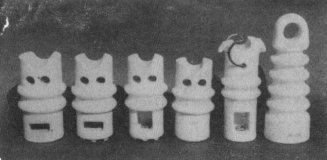
SPOOK!! Pictured above are six of 12 different Spook insulators in my
collection. We have had a couple of questions on these in the past, and I have
seen and heard some incorrect information about these insulators.
They are neon sign tube support insulators. Each has a threaded brass bushing
in the bottom for attaching to the sign, and the "eyes" are for tie
wires or spring clips. Note the spring clip in place on the second one from
right.
A number of the different electrical porcelain companions have made these as
contract items for the larger electric sign manufacturers and also as
proprietary items for their own catalog sales. In fact, a good portion of Union
Electrical Porcelain Company's business (Trenton) is their complete line of sign
insulators of all types.
Even though collectors do have their limits as to what they collect in
offbeat insulators, these are popular because of that truly ghostly shape.
Jack
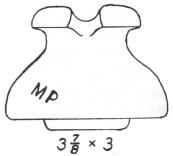
Dear Jack:
... picked up a couple of interesting insulators. The first one is a
chocolate brown Sim U-610A (see sketch at right) which has the M P marking
exactly the same letter style and size as on the beehives. This came from Paul
Folckemer (Buffalo) who got a couple from someone in Pennsylvania in a trade. I
think this marking on a cable is a little unusual, isn't it?
I also got from Mrs. Lucille Barlow one of the ponies in copper lustre. This
is the U-9 with the sand-rest base and is exactly the same as the chocolate
brown one; in fact, the chocolate shows in a couple of spots. It also shows wear
on wire rim and top and base, so looks authentic. Was this an experiment during
time of Corning's carnival glass era or possibly at the "radio
treatment" time?
In April Crown Jewels, page 17, you list a few items as still unreported. I
have the U-595, identical except that the crown is slightly different shape (par
for the course)
Lew Hohn,
Rochester, N.Y.
- - - - - - - - -
Dear Lew:
Yes indeed, customer markings (railroads) are highly unusual on cables and
the like. First I've heard of this. I also have P.R.R. on a U-529 feeder cable
insulator, but it's a questionable item, as I dug it in the Pittsburg dumpage.
We'll count it if anyone ever turns up one that was used on a line. Glad to find
someone actually has a U-595 specimen, a rather unusual cable shape.
I know absolutely nothing about those copper lustre items, but I feel it's
more likely they were an experiment on the part of some ceramic hobbiest! If I
quit seeing them at the flea markets and start seeing them on phone lines, I'll naturally change my tune.
Jack
This is not an insulator as we term them, but it is an unusual electrical
porcelain item. It does not show well in the photo, but this little porcelain
puppy (a bathroom fixture?) has conventional electrical outlets on its sides and
back.

I found this interesting gadget last year while rummaging through some bins
of old porcelain samples at Union Electrical Porcelain Co. in Trenton, N.J. When
you get this thing all wired up for electricity, you can then call it a
"hot dog". Right?

FIREPLUGS. This is a general review for those who are interested in these
insulators. Of all the many special wiring knobs, these are the most exciting
because they were manufactured and used in relatively large numbers and are thus
more readily obtainable by collectors.
These were patented (#954,596) April 12, 1910 by Albert L. Staderermann,
Terre Haute, Ind. All specimens I have seen have either this patent date on them
or a legend "PAT. PEND". The idea was to afford both a vertical and a
horizontal tying plane for a pair of wires on any mounting surface. There are
three sizes - the 1001, 1002 and 1003 (left to right in the above photo).
All specimens carry the tradename "UNIVERSAL" plus the size number
designation and a reference to the patent, but there are several variations of
location and arrangement of these markings on the insulators of each style. They
are also known with manufacturer's identification markings of Triangle-M
(Illinois) and F.O.P. (unattributed).
Fireplugs come in all shades of brown from light tan to nearly black, and
very rarely in white.
The 1002 size is the most common. At one time, it was thought the 1001 was
the least common, but a number of these have appeared upon the scene in the past
couple of years, and I would now rate the 1003 as the toughest one to find. Many
specimens have slight chipping about the sharp edge of the base or at the top of
the screw hole, and 100% mint ones are the exception to the rule.
For additional information, see Crown Jewels, July 1971, pages 18-19 and
Gerald Brown's 2nd Edition of Collectible
Porcelain Insulators, page 157.
Jack
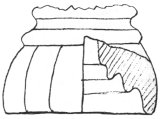
Dear Jack:
I have an Elliot flint-glass threadless which was recently found in a
construction excavation. It's the equal to the U-980 in the style chart, same
measurements, but there is one big difference. In the style chart drawing, and
also in the photo on page 11 of Frances Terrill's book, it clearly shows this
insulator as having three interior petticoats, but mine has only two petticoats.
I've enclosed a sketch (above) showing this, and you can compare it with the
U-980 drawing.

Maybe you know something of it already. If not maybe you can tell me
something
about it.
Warren Rogers
Willimantic, Conn.
- - - - - - - - -
Dear Warren:
No, I never noticed this. I drew the style chart drawing from the first
specimen that came along to my machine, and that's the way it was. Since then, I
have seen some of these in collections and several at a time at various shows,
but it never dawned on me to inspect the inside of each one for variations.
This slight variation is meaningless for any collector wanting one of these
for his display shelf, but may be a very, important factor in considering the
production of these insulators. The variation comes from use of two different
jiggering tools for this Elliot design, and note that these are still different
from the jiggering blades used for the U-979 and U-981 Elliots. This would
indicate substantial runs of these insulators being made at one time or their
manufacture over an extended period of time.
Trade literature of the time which "recommended" these insulators
flatly stated they were then in use on many lines, and collectors have turned
them up in most parts of New England plus Canada. All this put together seems to
indicate that considerable of these were made and used.
The U-980 and U-981 are both generally available for sale on lists and at
shows, but the U-979 is evidently a rarer item.
Jack
Dave Ramp, Lew Bohn, Robert Winkler and others report having insulators which
approximate the U-105 in our style chart, and the righthand drawing here is from
data Lew sent. The big question being - is this really the U-105. I have a
suspicion that these are two different animals and that if we merely revise the
U-105 drawing to this new thing, we'll have problems if specimens ever do show
up which fit the U-105 drawing now in the chart. It seems best then to tag this
new item U-104 and add it to the chart. Specimens of these came off of one
United Telephone Co. exchange in northern Indiana, and the fellows say they look
like a Pittsburg item from glaze and pin hole type.

Reproduced on the following page is a 1920 advertisement of Electrode
Manufacturing Co. which shows a number of composition insulators they cataloged.
Another large group of Electrode pin types is shown on page 54 of the Cranfill-
Kareofelas "Dictionary of Glass - Ceramic ...".
These listings might be helpful to those who collect these composition types.
I have seen a number of these different types, including one marked ''Electrode
Mfg. Co." but I rather think most of these were never actually made or
sold. Note in the C-K book they even cataloged a two-piece transposition and pin
types rated up to 22 Kv. I'd say they had some real losers with these designs.
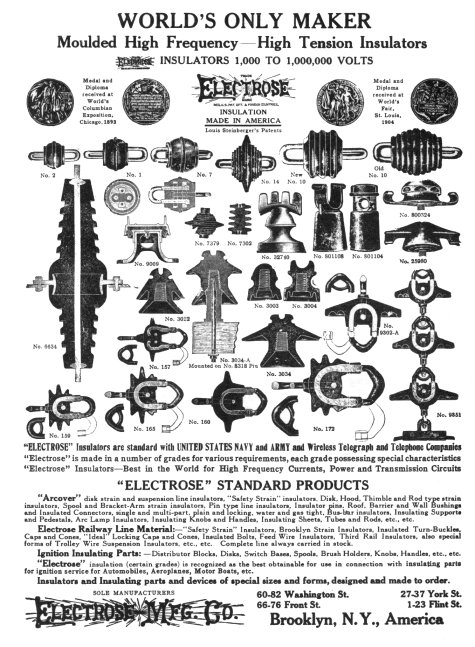
Large Image (108Kb)
| 